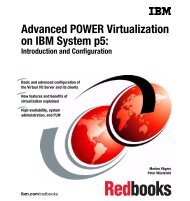string
string
string
You also want an ePaper? Increase the reach of your titles
YUMPU automatically turns print PDFs into web optimized ePapers that Google loves.
(Continuation)<br />
(ssd22):<br />
Error for Command: Error Level: Fatal<br />
Requested Block: 0 Error Block: 0<br />
Vendor: CONNER<br />
Serial Number: 93081LPT<br />
Sense Key: Aborted Command<br />
ASC: 0xb3 (), ASCQ: 0x0, FRU: 0x0<br />
WARNING:<br />
/iommu@0,10000000/sbus@0,10001000/SUNW,soc@2,0/SUNW,pln@a0000000,74127a/ssd@4,2<br />
(ssd22): ssd_synchronize_cache failed (5)<br />
Action<br />
In a High Availability system with NVRAM, this would be caused by unprocessed<br />
data in a NVRAM cache of the active logical host that has been down and come up<br />
later. Because of this, NVRAM should not be used in an HA system. The problem<br />
can be solved in this case by getting rid of the NVRAM on the HA system.<br />
In a non-HA system, this can also be caused by stale data in the NVRAM cache. (The<br />
example commands below assume the controller for the array is c1.) To fix for a<br />
non-HA system:<br />
1. Turn off all fast writes on this array and sync any remaining pending writes.<br />
# ssaadm fast_write -d c1<br />
# ssaadm sync_cache c1<br />
2. When you sync the fast writes to the array, all pending writes are physically made<br />
to the disks. Anything that is left in the cache is stale, and thus, it is safe to purge it.<br />
Run the command:<br />
# ssaadm purge c1<br />
3. Turn the fast writes for the disks back on. This command MAY be different on<br />
your system, depending on the disks on which you want fast writes enabled and the<br />
types of fast writes you want:<br />
# ssaadm fast_write -s -e c1<br />
140 Solaris Common Messages and Troubleshooting Guide ♦ October, 1998

















